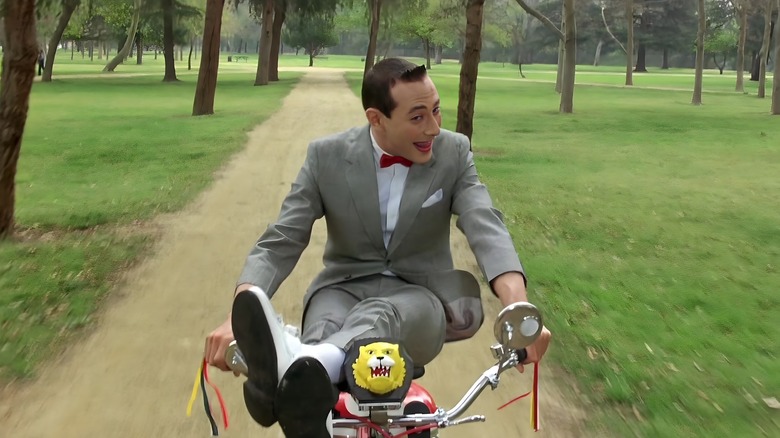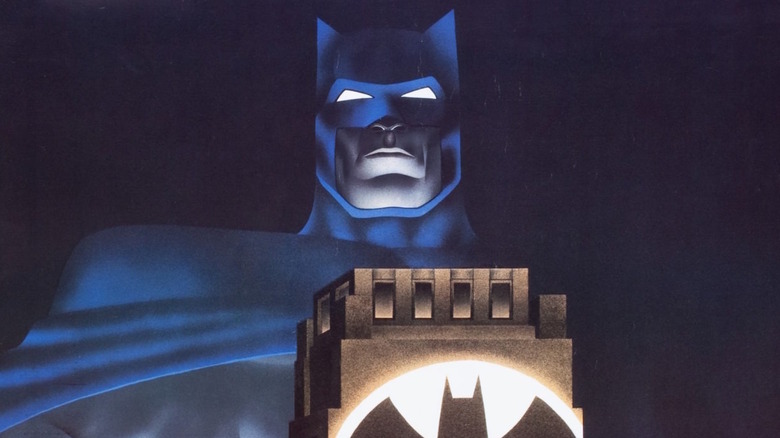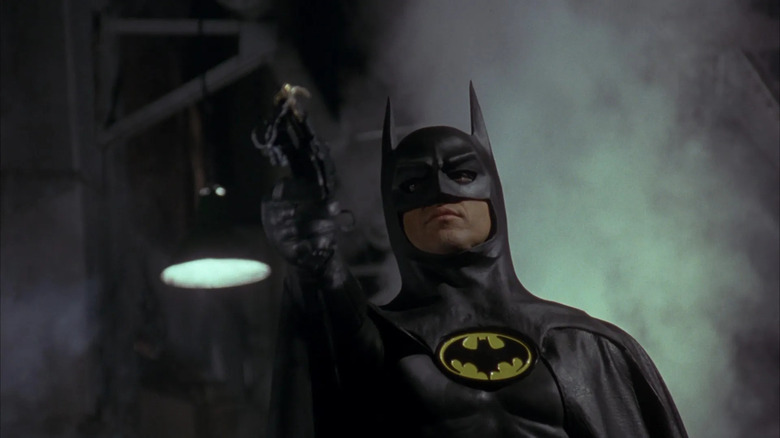How The Dark Knight Returns (And Pee-Wee Herman) Led To Tim Burton's Batman
The character of Pee-wee Herman — a chuckling, hilarious man-child invented by comedian Paul Reubens — made his debut in 1977 in the film "Cheech and Chong's Next Movie," and cemented his legacy in 1981's "Nice Dreams." In the latter film, clearly strung out on something, the Pee-wee-like character asked if Cheech was the "guy from the hamburger train."
The same year, still playing the Pee-wee shtick, Reubens debuted "The Pee-wee Herman Show" at the Groundlings Theater in Los Angeles, cementing the character in the local pop consciousness. The stage shows were quite expressly adult, even if Pee-wee himself was quirky and childish. Characters that debuted on stage would eventually appear on the popular TV show "Pee-wee's Playhouse" in 1986, including Jambi the Genie, Miss Yvonne, and Cowboy Curtis.
Prior to the TV series, however, Reubens had ambitions to bring Pee-wee Herman to cinemas. Because the actor had a book of working directors, he was aware of the early works of Tim Burton. By 1985, Burton had already made the stop-motion animated short called "Vincent," a tribute to Vincent Price, and "Frankenweenie," a charming short about a boy who resurrects his dead dog. Reubens knew that Burton had the right kind of off-kilter sensibility for Pee-wee Herman, and the director was hired. "Pee-wee's Big Adventure" was Burton's first feature.
In 1986, something equally significant happened that would also, eventually, come to hugely influence Tim Burton's career: comic book author Frank Miller would write and publish "The Dark Knight Returns," the bleakest, weirdest, most adult Batman story to date. The story took place in the near future when Bruce Wayne was in his 50s, and Gotham City was overrun by gangs called Mutants.
It would be a combination of Miller and Pee-wee that led Burton to helm the ultra-successful 1989 film "Batman."
The Dark Knight Returns
It should be noted that both Pee-wee Herman and "The Dark Knight Returns" were part of a trend to make kid-friendly material more assertively R-rated. Pee-wee's live stage shows were more along the lines of burlesque than children's entertainment, and Miller's version of Batman was heady and bloody in a way usually reserved for the pages of Heavy Metal Magazine. It's no wonder that a 1989 cinematic version of Batman should transform once-friendly, upbeat, colorful comics into a stylish, shadowy neo-noir.
The path to Tim Burton's "Batman" was, as one might imagine, long and circuitous. Mark S. Reinhart's 2011 book "The Batman Filmography: Live-action Features, 1943 – 1997" details the 1989 film's early production, which began almost a decade prior. According to Reinhart, there was a concerted effort throughout the 1970s to push Batman away from the colorful, comedic antics of his popular 1966 TV series. The creative team of Steve Englehart, Marshall Rogers, and Terry Austin were writing and drawing darker, more intense Batman stories at DC comics at the time, and Batman had undergone a serious tonal shift from the generation prior. The success of Richard Donner's feature film "Superman" in 1978 immediately had DC Comics looking to replicate it with other heroes.
The original screenplay for "Batman" was, by Reinhart's report, a lot more like "Superman," in that it told the hero's entire origin, and was possessed of the same "epic" qualities that marked Donner's film. Producers came on, others stepped off. It was around this time that Jack Nicholson was floated as a potential Joker. It languished for years.
Then, when Miller's book hit the newsstands, interest was refreshed, and the tone was set. The new "Batman" movie would be like that.
This is the version we want
The producers on the "Batman" project in 1985 — by then, it was Jon Peters and Peter Guber — said that the Englehart-Rogers-Austin version of Batman was out. It was all about Miller now. All the "epic" scripts that had been floating through Warner Bros. in the '70s and '80s were to be put down and a new, more Miller-like script was to be penned. The early, unused script by Tom Mankiewicz has, naturally, made its way online, and the curious can read it at their leisure.
But with a new "Dark Knight" version of Batman in the world, what director could possibly handle the material?
Pee-wee was right there.
"Pee-wee's Big Adventure" was a massive success for Warner Bros., and Tim Burton proved that he could take twisted kid-geared material, and turn it into something strange and adult. Although one might not see the tonal connection between Pee-wee and Frank Miller, they were seemingly cut from the same cloth. Burton was happy to tackle a major blockbuster and was permitted to bring his own Gothic sensibilities into the project. Burton, the producers felt, was already displaying underpinnings of sadness in his work, and were happy to have that broodiness — a key element of Miller's work — in the mix. Although Burton was not intimately familiar with Batman at the time and had never directed an action movie, he was hired.
Burton's film, part Miller and part Pee-wee, was one of the biggest hits of all time and dictated the look and tone of most Batmedia for the better part of the next 15 years. Sometimes, it seems, the bizarre alchemy just works.


